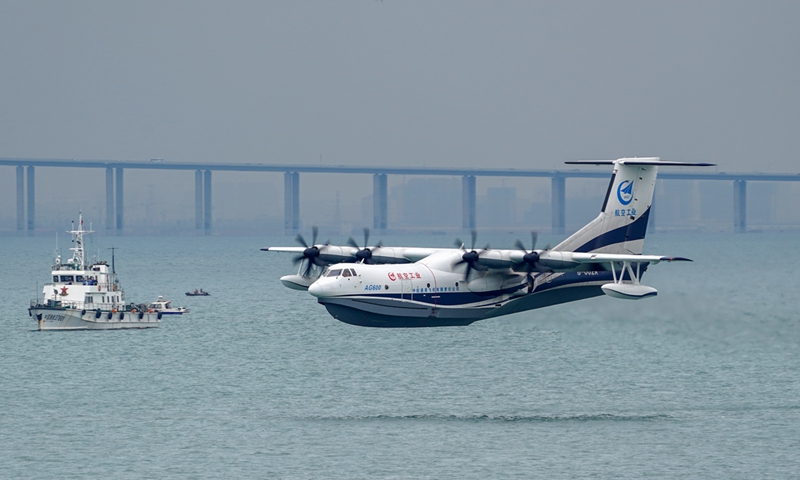China’s home-grown large amphibious aircraft AG600 makes 1st sea-based test flight
By Liu Xuanzun and Ma Jun Source: Global Times Published: 2020/7/26 12:17:04

China's domestically developed large amphibious aircraft AG600 makes its first sea-based test flight from sea waters off Qingdao, East China's Shandong Province on July 26, 2020. Photo: Courtesy of AVIC
China's domestically developed large amphibious aircraft AG600 successfully made its first sea-based test flight on Sunday. The test flight demonstrated the aircraft's ability to operate in challenging maritime conditions and conduct missions, including far sea cargo transport and maritime emergency rescue, the aircraft's developer said.
Analysts said the aircraft's potential deployment in the South China Sea will enhance China's ability to safeguard national sovereignty and territorial integrity, as its future presence would contribute to China's civil administration practice in the region, and help in search and rescue missions for those in need from other countries in a move that shows China's image as a responsible major country.
The AG600 aircraft took off from waters near the coastal city of Qingdao, East China's Shandong Province, on Sunday morning. It was on show for around 31 minutes and finished a set of test maneuvers in the sky, before landing at an airport in Rizhao, Shandong Province.
The event marked the success of the AG600's first sea-based test flight, the aircraft's developer Aviation Industry Corp of China (AVIC) said in a statement sent to the Global Times on Sunday.
The AG600 conducted its land-based maiden flight in Zhuhai, South China's Guangdong Province, in December of 2017, and its first water-based test flight over a reservoir in Jingmen, Central China's Hubei Province in October of 2018.
The aircraft's sea-based test flight demonstrated its performance in sea waves and corrosive environments that have high salinity and humidity, said AVIC.
AVIC said that sea water is different to fresh waters in terms of salinity, density and waves, and the pilot also faced more complicated environments, meaning that sea-based test flights are much harder compared to previous water-based test flights.
It also prepared the aircraft to conduct missions, including far sea cargo transport and maritime emergency rescue, in the future, the company said.
Wang Ya'nan, a Chinese aviation industry expert and chief editor of the Aerospace Knowledge magazine, told the Global Times on Sunday that previous water-based test flights took place in a reservoir that was safe and did not have large waves.
A test flight at sea is more challenging as uncontrollable factors come into play, including waves and corrosions that could possibly cause malfunctions to occur in the aircraft's systems, Wang said.
The successful sea-based test flight indicated the AG600 has now basically reached its designed goal. Its next steps will likely involve more test flights as well as tests that challenge the plane's ability to resist sea water corrosion for extended periods, carry heavy cargo, and put out fire, Wang said.
The AG600 is China's first domestically developed special mission civilian aircraft aimed mainly at meeting the country's needs for forest firefighting and maritime rescue operations, AVIC said.
In a firefighting mission, the aircraft can hold up to 12 tons of water either directly drawn from water surfaces or filled manually at an airport. It can use the water to spray and cover an area of more than 4,000 square meters.
In search and rescue missions, it can fly low above the water's surface, land on water when needed, and save up to 50 people in dangerous environments.
When needed, the AG600 can be customized with additional equipment to conduct other special missions, AVIC said.
Chinese military expert Yin Zhuo told China Central Television previously that the AG600 is also suitable for military operations, such as patrol and anti-submarine missions.
The amphibious aircraft is expected to be delivered by 2022, the Xinhua News Agency reported in 2018.
Since its development, experts and media reports have suggested that the AG600 will shine in the South China Sea.
When deployed from Sanya, South China's Hainan Province, the AG600 can reach any location in the South China Sea thanks to its endurance of up to 12 hours, maximum speed of 500 kilometers an hour, and ability to take off and land on water, people.cn reported.
With ships, it would take approximately one week to reach the southernmost point of the South China Sea from Sanya; however, with the AG600, it would take only two hours, an AVIC manager told media previously.
At a sensitive time when tensions are rising in the South China Sea due to countries from outside the region interfering, like the US, the first sea-based test flight of the AG600 again showed its potential in safeguarding China's national sovereignty and territorial integrity.
Chen Xiangmiao, a research fellow at the Hainan Province-based National Institute for South China Sea Studies, told the Global Times on Sunday that unlike the US, which has been pushing for militarization in the South China Sea, China is becoming more capable of providing international public services, including maritime search and rescue, and salvaging.
Accidents of ships from different countries that pass by continue to occur in the South China Sea, and the region's difficult maritime environment could prove challenging for rescue missions that use ships, Chen said, noting that the AG600 could help in such cases, and it would show China's image as a responsible major country.
By providing these public services, China will be able to prove its presence in the region and demonstrate its practice of civil administration, Chen said.
In April, the city of Sansha in Hainan Province announced the establishment of two new districts, the Xisha and Nansha districts, to administer the waters in the South China Sea.
RELATED ARTICLES: